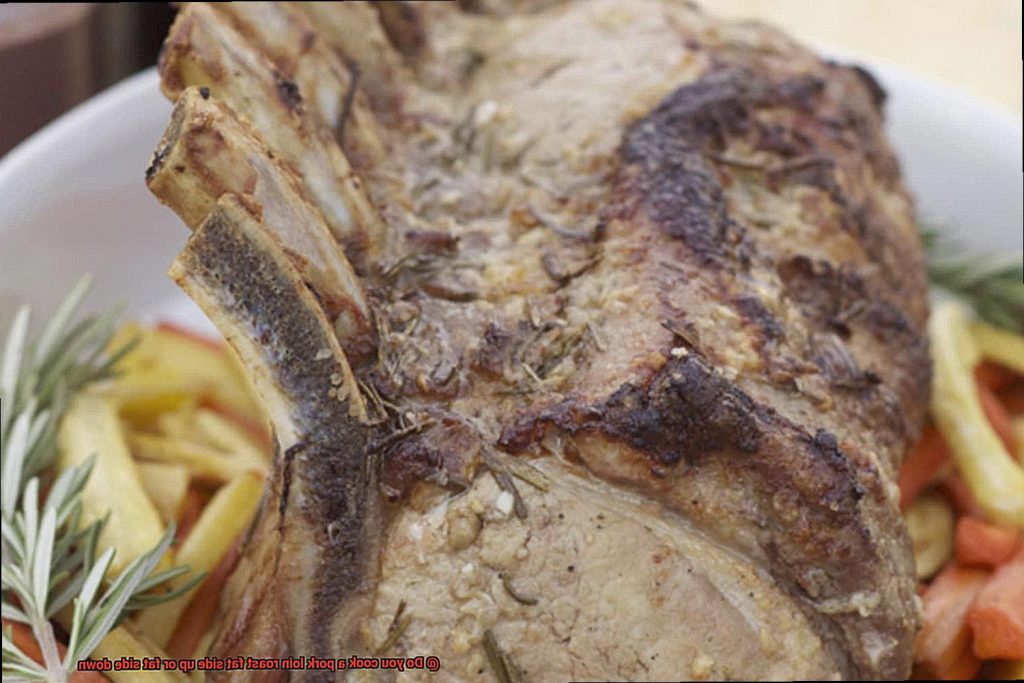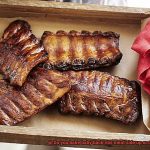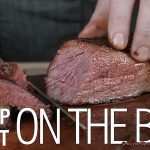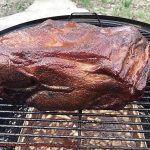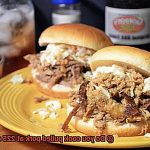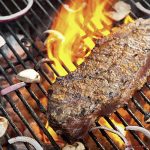Let’s dive into the debate and discover whether cooking a pork loin roast fat side up or down is the key to culinary success.
Cooking a pork loin roast can be an absolute delight. The anticipation of a juicy, tender roast with crispy crackling is enough to make any food lover’s mouth water. But amidst the excitement, one question always seems to arise: should you cook it with the fat side up or down?
Now, before we delve into this age-old debate, let’s take a moment to understand the pros and cons of each method. By doing so, we can make an informed decision that will lead us to pork perfection.
Traditionally, many cooks opt to position the pork loin roast with the fat side up. It’s like dressing your meal for success. The logic behind this method is simple yet effective: as the roast cooks, the fat melts slowly and bastes the meat from within. This results in a moist and succulent masterpiece that will have your taste buds dancing with joy. Plus, cooking with the fat side up allows for that coveted crispy crackling – a delightful contrast of textures that adds an extra layer of culinary satisfaction.
However, there are slight downsides to this technique as well. While the fat enhances flavor and juiciness, it may not render entirely during cooking. This means you could end up with a layer of unappealing partially rendered fat on top of your otherwise delicious creation. Additionally, cooking with the fat side up can impede direct heat exposure for the meat, potentially resulting in an unevenly cooked interior.
On the flip side, cooking a pork loin roast with the fat side down offers its own set of advantages. By positioning the fat side down, you allow it to act as a protective shield against direct heat – like wrapping your precious roast in a cozy blanket.
This insulation prevents excessive drying, ensuring your roast remains moist and tender throughout the cooking process. Plus, with the fat side down, the natural juices of the roast can flow through the meat, further contributing to its optimal tenderness.
Of course, every technique has its trade-offs. Cooking with the fat side down means sacrificing some of that crispy crackling goodness. Without direct exposure to heat, achieving that perfect contrast in textures becomes a bit more challenging. Additionally, cooking with the fat side down may not provide the same basting effect as when it’s cooked fat side up.
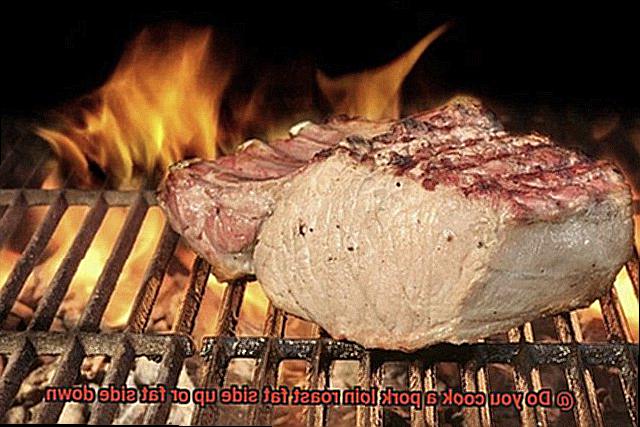
Contents
The Debate: Fat Side Up or Fat Side Down?
This seemingly innocent question has divided opinions and ignited fiery arguments for years.
On one side of the debate are those who swear by cooking the roast with the fat side up. They argue that this method allows the fat to melt and drip down into the meat as it cooks. This self-basting effect not only keeps the roast moist and tender but also infuses it with incredible flavors from the rendered fat. Each bite becomes a succulent explosion of taste, thanks to this technique.
But, on the other side, there are those who firmly believe that cooking a pork loin roast with the fat side down is the only way to go. Their argument is compelling – by placing the fat side down, the layer of fat acts as a protective barrier against direct heat. This insulates the lean meat and greatly reduces the risk of it drying out. In addition, this method allows for a beautifully seared and caramelized crust on the exterior, adding a delightful texture to each mouthwatering bite.
The pros and cons of each method are clear. Cooking with the fat side up results in a self-basting effect, enhanced juiciness, and flavor infusion. However, it also carries the risk of greasiness and inconsistent browning. On the other hand, cooking with the fat side down protects against drying out and creates a crispy crust, but it may lead to potential dryness and limited flavor infusion.
So, which method is superior? The answer lies in personal preference and desired outcome. If you yearn for a roast that is juicy, flavorful, and bastes itself throughout the cooking process, then cooking with the fat side up may be your ideal choice. However, if you crave a roast that is perfectly protected against drying out, with a golden, crispy crust that adds a satisfying crunch to each bite, then cooking with the fat side down is the way to go.
Regardless of which method you choose, there are a few key factors to keep in mind for a successful pork loin roast. Proper seasoning with salt, pepper, and other desired spices is crucial for developing the flavors. Additionally, using an accurate meat thermometer to monitor the internal temperature will help you avoid overcooking or undercooking the roast.
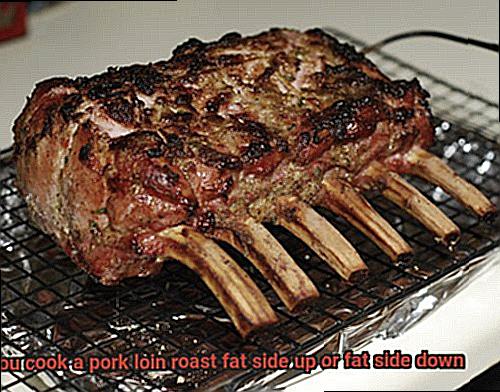
Pros and Cons of Cooking with the Fat Side Up
In this detailed analysis, we will explore the pros and cons of cooking with the fat side up, catering to readers who aspire to achieve succulent and flavorful meats on their grills. While personal preference undoubtedly plays a significant role in this decision, understanding the potential benefits and drawbacks can empower you to make an informed choice that will elevate your culinary prowess.
Pros:
- Self-basting: Cooking with the fat side up allows the luscious layer of fat to melt and baste the meat as it cooks, resulting in a tantalizingly juicy and moreishly flavorful roast. This self-basting effect ensures that every bite bursts with succulence, leaving your taste buds dancing in delight.
- Insulation: The generous layer of fat acts as a vigilant insulator, shielding the meat from direct heat and preventing it from drying out. This method preserves the desired moisture levels throughout the cooking process, gifting you with tender cuts that melt in your mouth.
- Moisture retention: As the fat renders down, it creates an impenetrable barrier between the meat and the cooking surface, guarding against moisture loss. This technique is particularly invaluable for lean cuts that are prone to rapid dehydration, ensuring that your dish remains moist and delectable till the very last bite.
- Enhanced flavor: The lush fat deposits impart an irresistible richness and divine flavor to the meat, elevating its overall taste profile to sublime heights. By cooking with the fat side up, you allow these captivating flavors ample opportunities to permeate every fiber of the roast, transforming it into a culinary masterpiece that will leave your guests begging for seconds.
- Visual appeal: Cooking with the fat side up bestows upon your masterpiece an alluring visual charisma. The fat, as it browns and caramelizes during cooking, creates a captivating crust that teases the eyes and whets the appetite, promising a gustatory experience that is as visually gratifying as it is delicious.
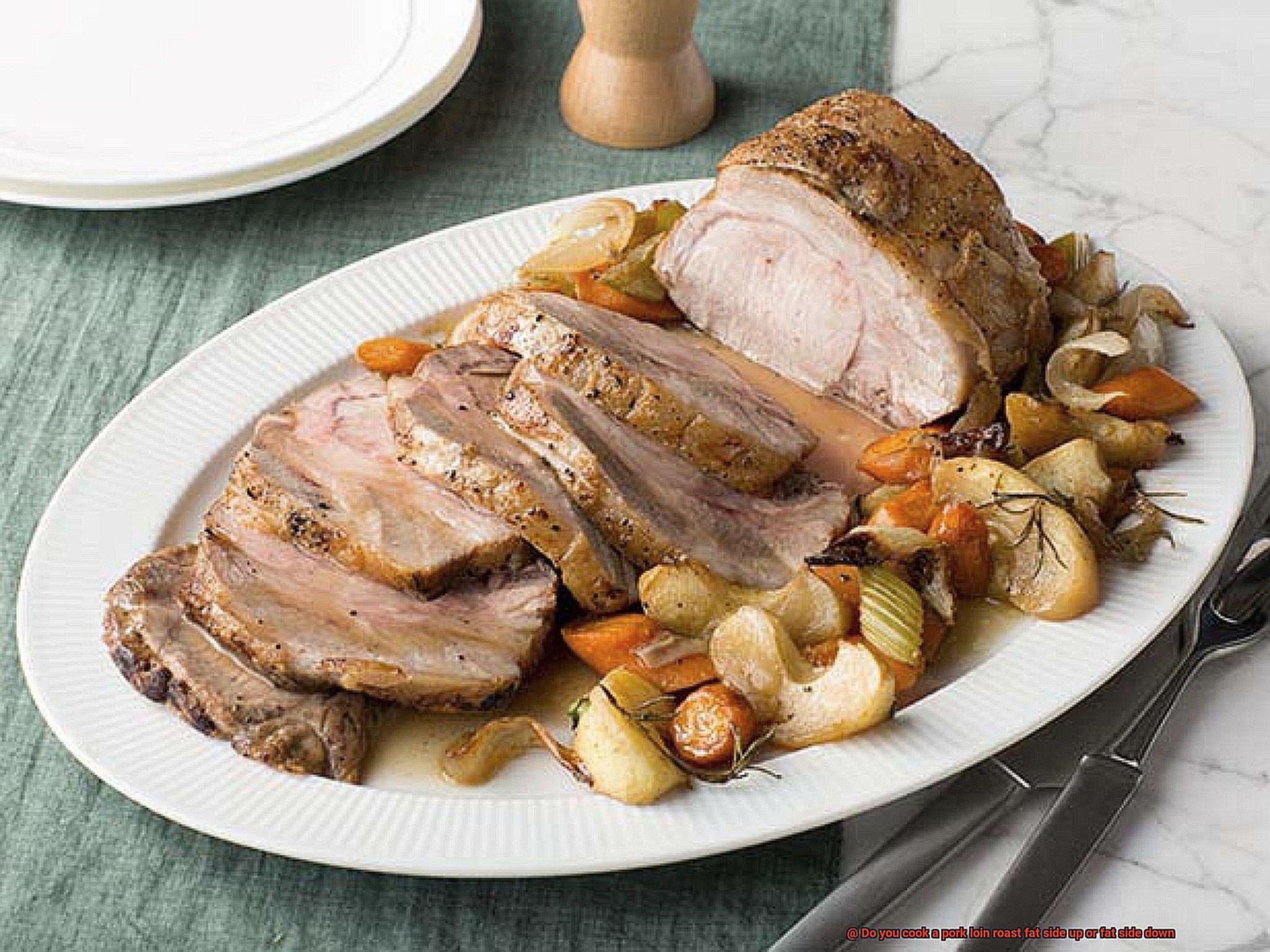
Cons:
- Greasier texture: If the fat fails to render down completely during cooking, it may result in a slightly greasier texture and mouthfeel. However, with meticulous trimming and scoring before cooking, you can minimize this potential pitfall and achieve a harmonious balance of succulence and tenderness.
- Chewy or rubbery fat: Inadequate trimming of excess fat can lead to an unfortunate consequence—a chewy or rubbery texture that detracts from the eating experience. By investing time and effort in carefully removing any superfluous fat, you can ensure that your roast remains a delightfully tender affair.
- Limited seasoning penetration: Cooking with the fat side up may present a minor limitation when it comes to seasonings or marinades penetrating deeply into the meat. The layer of fat can act as a barrier, hindering the full infusion of flavors. However, by properly seasoning and marinating the meat beforehand, you can counteract this drawback and achieve a harmonious balance of flavors that will leave your palate enchanted.
- Limited smoke infusion: The presence of the fat layer may partially obstruct the full infusion of smoke or grill flavors into the meat, potentially reducing the smoky aroma and tantalizing taste that grilling aficionados crave. However, by judiciously adjusting your cooking techniques and ensuring adequate exposure to smoke, you can still achieve a delightful smoky essence that will elevate your dish to new heights.
- Uneven cooking: On certain occasions, cooking with the fat side up may result in slight inconsistencies in doneness. The top of the roast may cook faster than the bottom, leading to a minor imbalance that can be remedied with careful monitoring and rotation during the cooking process.
Pros and Cons of Cooking with the Fat Side Down
Cooking with the fat side down has its advantages and disadvantages when preparing a pork loin roast. Let’s explore the pros and cons in more detail.
Pros:
- Moisture retention: When cooking with the fat side down, the fat acts as a protective barrier, preventing the moisture in the meat from evaporating too quickly. This helps to retain moisture, resulting in a juicier and more tender roast.
- Flavorful crust: Another benefit of cooking with the fat side down is that it allows the fat to render and melt, creating a delicious crust on the bottom of the roast. This adds richness and depth of flavor to the meat, enhancing its overall taste.
- Even browning: Cooking with the fat side down promotes even browning and caramelization. As the fat melts and seeps into the meat, it helps to create a beautiful golden crust on the bottom of the roast, giving it an appetizing appearance.
- Easier carving: The fat acts as a natural barrier when cooking with the fat side down, making it easier to separate the meat from the fat when carving. This simplifies the process and ensures that each slice is served without unwanted fatty portions.
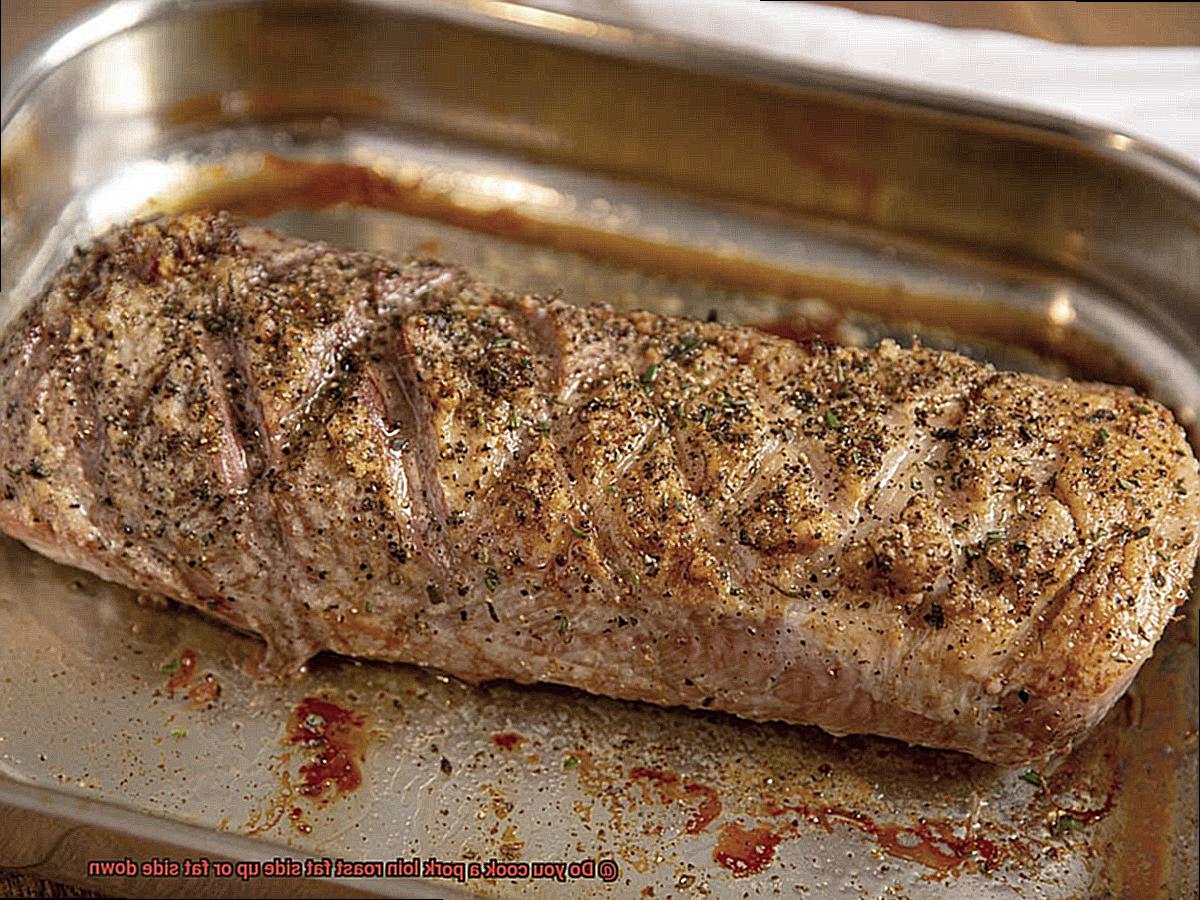
Cons:
- Greasier final product: One drawback of cooking with the fat side down is that there is a possibility that the fat may not render completely, resulting in a greasier final product. To mitigate this, one can trim excess fat before cooking or flip the roast halfway through to allow the fat to render evenly.
- Less crispy exterior: Cooking with the fat side down may lead to a less crispy exterior on the top of the roast. If a crispy crust is desired, it may be better to cook the roast with the fat side up, allowing it to crisp and brown during cooking.
It’s important to consider personal preference and individual recipes when deciding whether to cook a pork loin roast with the fat side down or up. Some chefs and home cooks have their own experiences and desired outcomes, which may influence their choice of cooking method.
Tips for Ensuring a Perfectly Cooked Pork Loin Roast
Start with a high-quality pork loin roast: Begin by selecting a fresh, well-marbled pork loin roast from a trusted source. Look for a roast with a generous layer of fat on top, as this will add flavor and juiciness to the final dish. Avoid choosing a roast with too much fat, as it may result in a greasy finished product.
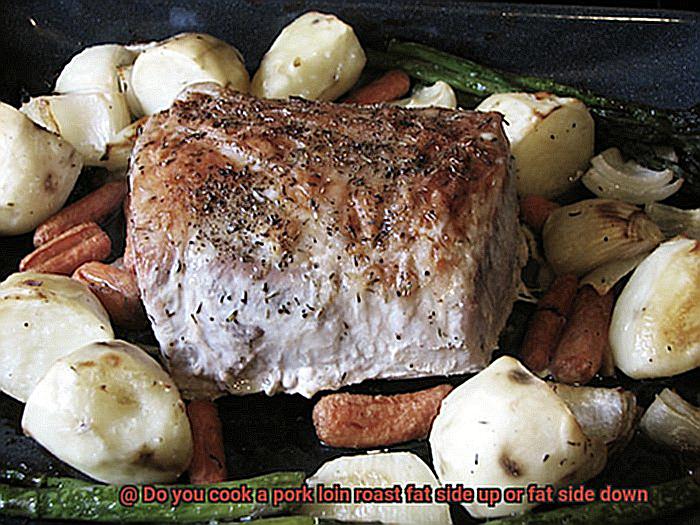
Allow the roast to come to room temperature
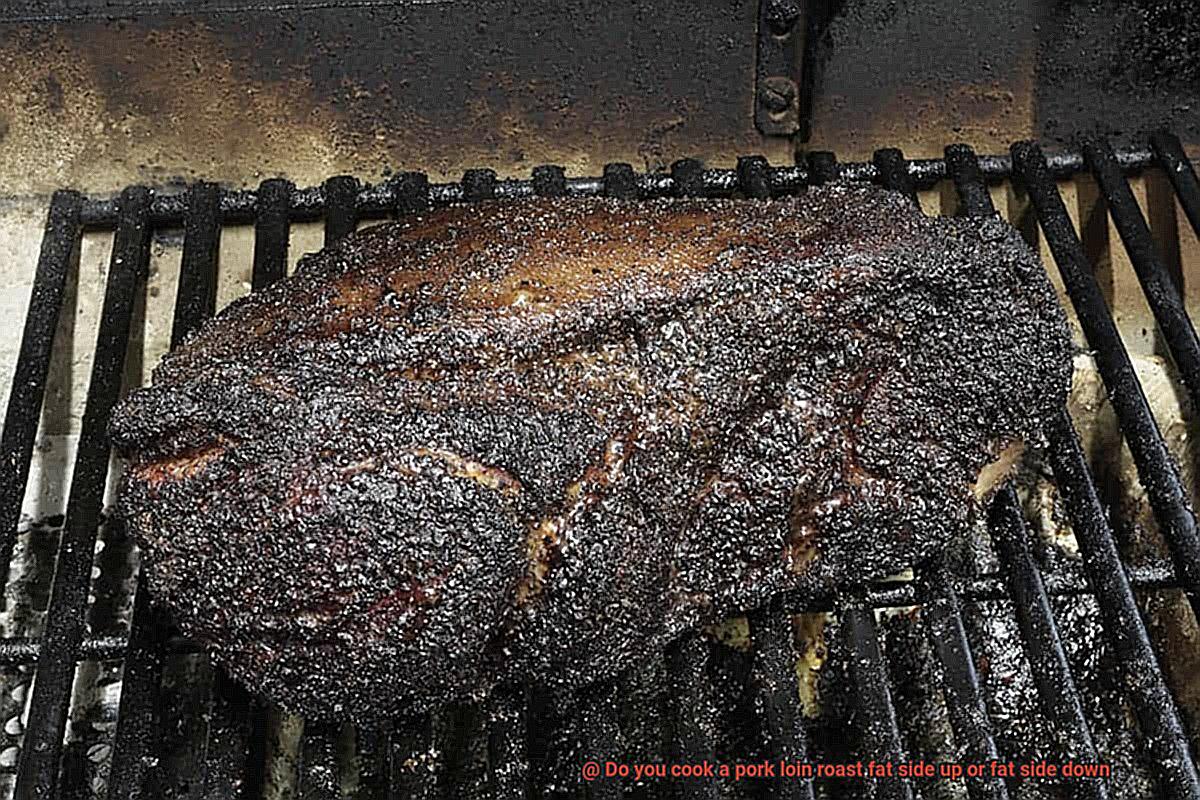
Before cooking, it is crucial to let the pork loin roast sit at room temperature for about 30 minutes. This step ensures that the meat cooks evenly throughout and results in a juicy end product. Allowing the roast to come to room temperature also reduces cooking time, preventing the meat from drying out.
Season the roast generously
To enhance the flavor of the pork loin roast, season it generously with salt, pepper, and your favorite herbs and spices. You can create a simple rub using garlic powder, paprika, thyme, and rosemary for added depth of flavor. Massage the seasoning into the meat, ensuring that all sides are covered.
Preheat the oven or grill
Whether you choose to cook the pork loin roast in the oven or on the grill, it is essential to preheat it to the desired temperature before placing the roast inside. This step helps achieve even cooking and prevents the meat from drying out. For an oven-cooked roast, preheat to 375°F (190°C). For grilling, preheat the grill to medium-high heat.
Use a meat thermometer
The key to achieving a perfectly cooked pork loin roast is using a meat thermometer. Insert the thermometer into the thickest part of the meat, making sure not to touch any bones. The internal temperature should reach 145°F (63°C) for medium-rare or 160°F (71°C) for medium. This ensures that the meat is cooked to a safe temperature while remaining juicy and tender.
Let the roast rest before slicing
Once the pork loin roast reaches the desired internal temperature, remove it from the oven or grill and let it rest for about 10-15 minutes before slicing. This crucial step allows the juices to redistribute throughout the meat, resulting in a more flavorful and tender roast. Resting also prevents the juices from spilling out when sliced, ensuring a juicy end product.
What Recipes or Techniques Specify a Particular Method?
Grilling a pork loin roast requires specific recipes and techniques to achieve the desired results. Grilling adds a smoky flavor and creates a beautifully charred exterior. Let’s explore the sub-topics and techniques that will help you grill the perfect pork loin roast.
First, it is important to select a high-quality pork loin roast. Look for one that is well-marbled and has a good amount of fat cap on top. Allowing the roast to come to room temperature before grilling ensures even cooking throughout.
Next, generously season the pork loin roast with your favorite dry rub or marinade. Popular flavors for pork include garlic, rosemary, thyme, paprika, salt, and pepper. Massage the seasonings into the meat, coating all sides evenly.
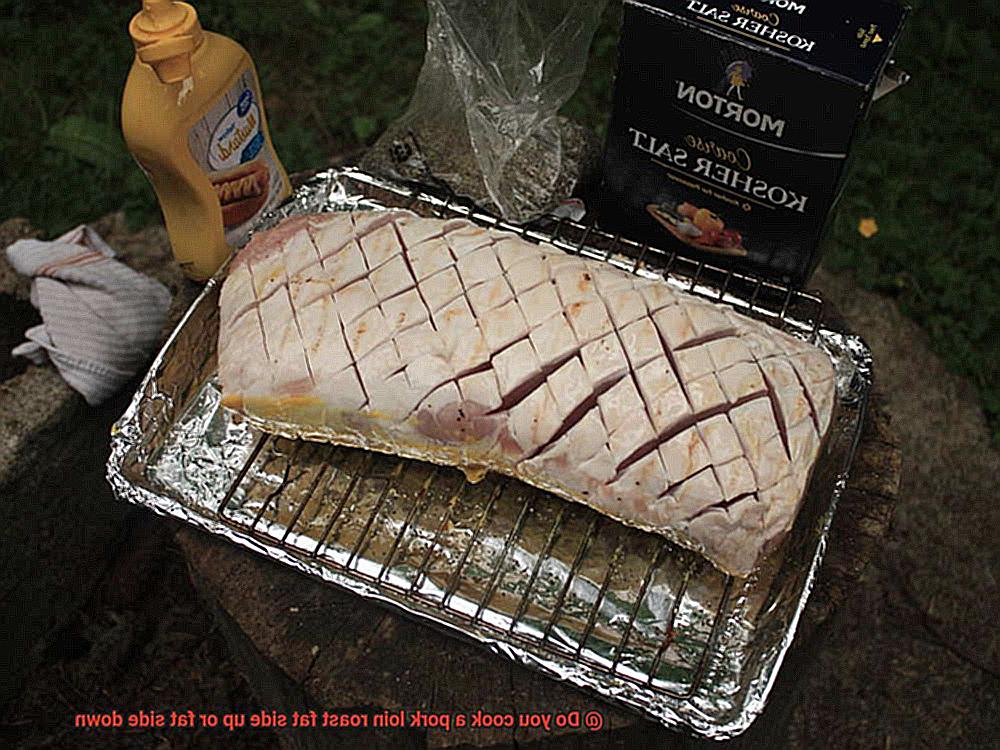
Preheating the grill to medium-high heat is crucial. Aim for a temperature of around 400°F (200°C). Clean and oil the grill grates to prevent sticking.
When placing the pork loin roast on the grill, you can choose to position it fat side up or fat side down. If grilling fat side up, the melting fat will baste the meat, resulting in a juicier roast with a crispy exterior. On the other hand, grilling fat side down acts as an insulator, preventing excessive rendering of fat and potential overcooking.
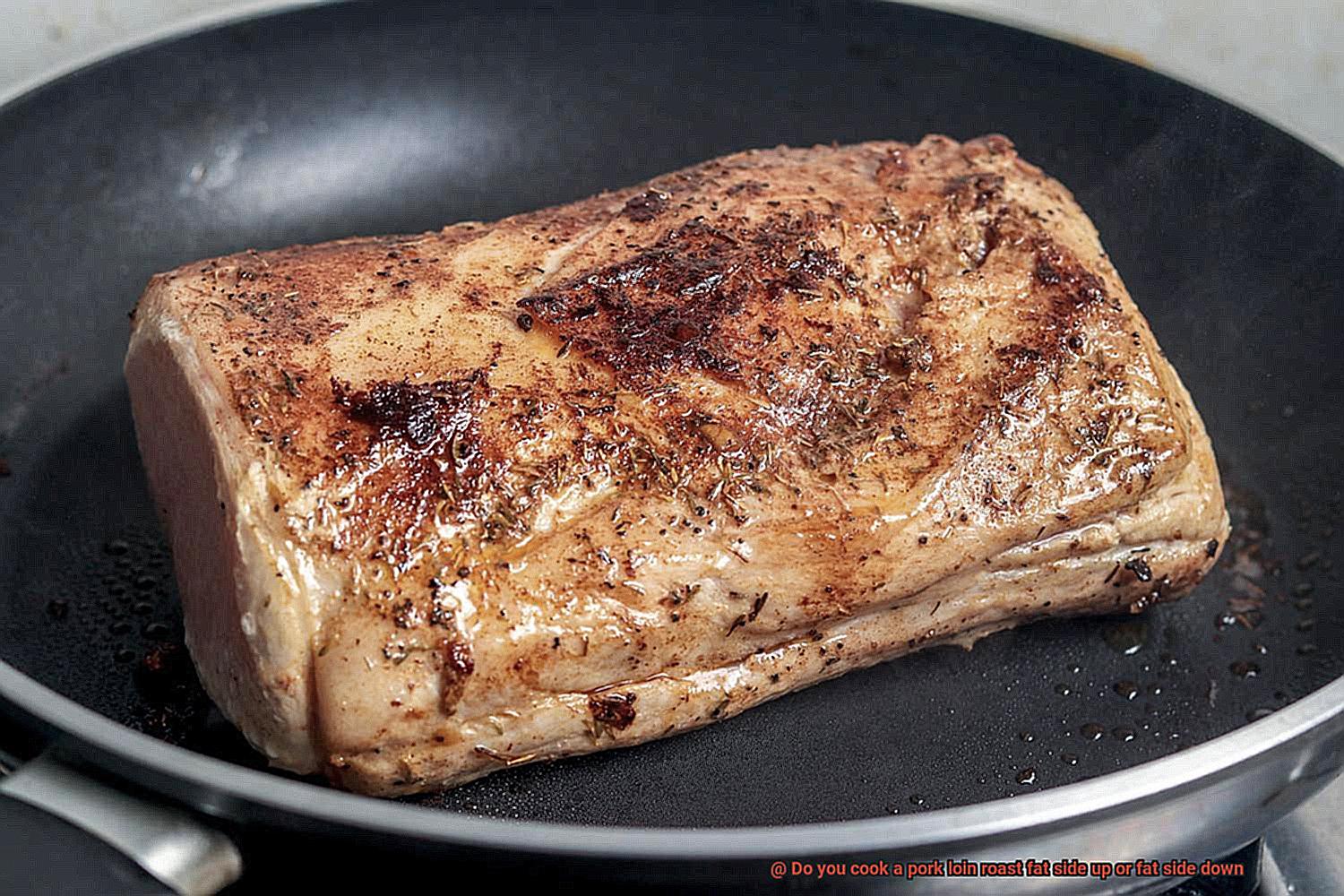
Close the lid of the grill and cook the roast for about 20 minutes per pound, turning occasionally for even cooking. Use a meat thermometer to check for doneness. The internal temperature should reach 145°F (63°C) for medium-rare or 160°F (71°C) for medium.
Once cooked, let the pork loin roast rest for about 10 minutes before slicing. This allows the juices to redistribute for a juicy and flavorful final result.
Experimenting with Different Methods to Find Your Favorite
Firstly, let’s talk about exploration. Delve into the depths of your interests and passions. Make a list of activities that pique your curiosity. From painting to rock climbing, from cooking to playing an instrument, the possibilities are endless. Don’t be afraid to step out of your comfort zone and try something new. You never know what might ignite a fire within you.
Once you have your list, it’s time for the grand experiment. Start by dedicating a specific amount of time to each activity. Immerse yourself completely, allowing the experience to wash over you like a tidal wave. Pay attention to how each activity makes you feel – Do you feel alive and invigorated? Do you find yourself losing track of time? These are signs that you may have stumbled upon something special.
Don’t be discouraged if the first few attempts don’t resonate with your soul. Rome wasn’t built in a day, and neither is your favorite pastime. Keep experimenting, keep exploring, and keep an open mind. Remember, greatness often lies just beyond our comfort zones.
As you continue on this journey of self-discovery, take note of what sparks joy within you. Is it the adrenaline rush of conquering a mountain? The serenity of losing yourself in a melody? Or perhaps it’s the therapeutic process of creating something beautiful with your own hands. Each experience is a clue on the path to finding your favorite.
Finally, embrace the fact that your preferences may change over time. What once excited you may lose its luster as you grow and evolve. Be open to the possibility of new favorites, and never stop experimenting.
Common Mistakes to Avoid When Cooking a Pork Loin Roast
Cooking a pork loin roast can be a mouthwatering experience, but it’s essential to avoid common mistakes that can lead to disappointing results. In this article, we will explore the top mistakes to avoid when cooking a pork loin roast, ensuring that you achieve a juicy and flavorful meal every time.
Improper Seasoning:
Don’t let your pork loin roast be bland and boring. Many people make the mistake of not seasoning the meat adequately. Before cooking, generously season the pork loin with salt, pepper, and any desired herbs or spices. This will infuse the meat with delicious flavors and create a tantalizing crust.
Overcooking:
Say goodbye to dry and tough pork loin roasts. Overcooking is a common mistake that can ruin your meal. Use a meat thermometer to ensure the internal temperature reaches 145°F (63°C), the recommended safe temperature for pork. Remove the roast from the heat as soon as it reaches this temperature to prevent overcooking.
Skipping the Resting Period:
Don’t rush to slice your pork loin roast right away. Allowing it to rest is crucial for a tender and moist final product. Give your roast at least 10-15 minutes to rest before slicing and serving. This allows the juices to redistribute throughout the meat, resulting in a more flavorful and succulent roast.
Improper Cooking Techniques:
Don’t let your grilling skills be subpar. Proper grilling techniques are essential for optimal results when cooking a pork loin roast. Ensure that your grill is properly preheated before placing the roast on it. This initial high heat sears the outside of the meat, sealing in its natural juices and flavors.
Slicing Too Soon:
Patience is key when it comes to slicing a pork loin roast. Cutting into the meat too soon can cause the flavorful juices to escape, resulting in a drier roast. Allow the pork loin to cool slightly before slicing it against the grain into thin, juicy slices.
DFpJKwz3McE” >
Conclusion
When it comes to cooking a pork loin roast, the age-old debate of whether to cook it fat side up or fat side down has caused many kitchen arguments. But fear not, for I am here to shed some light on this culinary conundrum.
Traditionally, the common belief was that cooking the pork loin roast with the fat side up would allow the melting fat to baste the meat as it cooks, resulting in a juicier and more flavorful roast. However, there is another school of thought that argues for cooking it fat side down.
Those in favor of cooking the pork loin roast fat side down argue that this method allows the fat to render and melt into the meat, creating a moist and succulent interior while still maintaining a crispy exterior. They believe that by placing the fat directly on the heat source, it helps to crisp up the surface of the roast.
So which method should you choose? Well, ultimately, it comes down to personal preference. Experimentation is key when it comes to cooking, so don’t be afraid to try both methods and see which one yields your desired results.
Regardless of whether you choose to cook your pork loin roast with the fat side up or down, there are a few essential tips to keep in mind. First and foremost, make sure to season your roast generously with salt and pepper before cooking. This will enhance its natural flavors and create a delicious crust.
Additionally, using a meat thermometer is crucial in ensuring that your roast is cooked to perfection. The ideal internal temperature for a pork loin roast is around 145°F (63°C). Remember to let your roast rest for a few minutes before carving to allow the juices to redistribute throughout the meat.
In conclusion, whether you decide to cook your pork loin roast fat side up or down depends on your personal preference and desired outcome. Whichever method you choose, just remember to season well, use a meat thermometer for accuracy, and let your roast rest before serving. With these tips in mind, you’re well on your way to creating a mouthwatering pork loin roast that will leave everyone at the dinner table begging for seconds.

